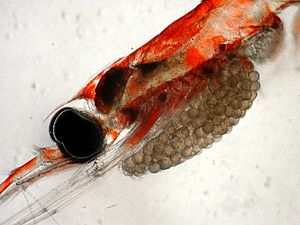Krill facts for kids
Quick facts for kids Krill |
|
|---|---|
 |
|
| A krill called the Northern krill (Meganyctiphanes norvegica) | |
| Scientific classification |
|
| Kingdom: | Animalia |
| Phylum: | Arthropoda |
| Subphylum: | Crustacea |
| Class: | Malacostraca |
| Superorder: | Eucarida |
| Order: | Euphausiacea Dana, 1852 |
| Families and genera | |
|
|
Krill are tiny ocean creatures that look a bit like shrimp. They are a type of crustacean found in all the world's oceans. The word "krill" comes from Norwegian and means "small fish fry."
Krill are super important in the ocean's food chain. They are near the bottom of this chain. Krill eat tiny plants in the ocean called phytoplankton, and sometimes other small animals called zooplankton. Many larger animals, like whales, seals, penguins, and fish, eat krill.
In the Southern Ocean, a type called Antarctic krill has a huge total weight, more than any other animal species. Over half of this massive amount is eaten by predators every year! Most krill species move up and down in the water each day. This means they provide food for animals near the surface at night and for animals in deeper water during the day.
People also fish for krill, especially in the Southern Ocean and near Japan. Most of the krill caught is used to feed fish in farms or aquariums. It's also used as bait for fishing or in medicines. In some countries like Japan, the Philippines, and Russia, people eat krill too.
Contents
Where Krill Live
Krill live all over the world's oceans. Some species live only in certain areas, like along coastlines. One deep-sea species, Bentheuphausia amblyops, lives in deep waters everywhere.
Different types of krill live in the Atlantic and Pacific oceans. For example, Euphausia pacifica lives in the Pacific. Northern krill live across the Atlantic, from the Mediterranean Sea northwards.
Some krill species, like those in the genus Nyctiphanes, live mostly near coastlines. They are very common in areas where deep, cold water rises to the surface, bringing lots of nutrients.
In the Antarctic, there are seven known species of krill. The Antarctic krill (Euphausia superba) usually lives about 100 m (330 ft) deep. Another type, ice krill (Euphausia crystallorophias), can go as deep as 4,000 m (13,100 ft), but usually stays between 300–600 m (1,000–2,000 ft). Krill often swim up and down in large groups, sometimes moving as much as 400 m (1,310 ft) in a day.
Krill Body Parts
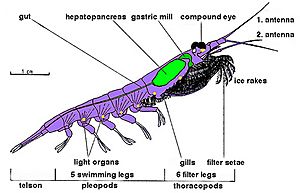
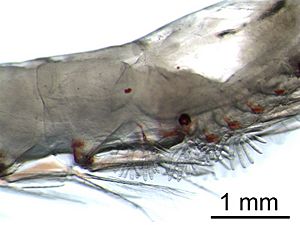
Krill are decapod crustaceans. This means they have a hard outer shell, like a crab or lobster. Their bodies have three main parts:
- The head and thorax are joined together to form the "cephalothorax."
- The "pleon" is the middle part, which has ten swimming legs.
- The "tail fan" is at the very end.
Most krill have a see-through outer shell. They have amazing compound eyes, which help them see. Some krill can change how their eyes work to see better in different light.
Krill also have two antennae and several pairs of legs on their thorax. These legs help them eat and clean themselves. They also have five pairs of swimming legs, called "swimmerets," which look a lot like those of a lobster.
Most adult krill are about 1–2 centimetres (0.4–0.8 in) long. But some can grow much bigger, up to 6–15 centimetres (2.4–5.9 in). The biggest krill, Thysanopoda spinicaudata, lives deep in the open ocean. You can easily tell krill apart from other crustaceans like shrimp because their gills are visible on the outside of their bodies.
Almost all krill can make their own light! They have special organs called photophores that glow. This light is made by a chemical reaction inside their bodies. Scientists aren't sure exactly why krill glow. It might be for finding mates, talking to each other, or even to hide from predators by matching the light from above.
Krill in Their Environment

What Krill Eat
Many krill are "filter feeders." They have special comb-like legs that they use to filter tiny food particles from the water. They mostly eat phytoplankton, which are like tiny ocean plants, especially diatoms. Most krill eat both plants and animals (omnivores), but a few species are carnivores, meaning they only eat other small animals or fish larvae.
Krill are a very important part of the ocean's food web. They turn the energy from tiny algae into a form that larger animals can eat.
Who Eats Krill
Many animals eat krill, from small fish and penguins to large seals and huge baleen whales.
If there are fewer krill in an area, it can cause big problems for other animals. For example, in 1998, a type of tiny algae that krill can't eat became very common in the Bering Sea. This caused the krill population to drop, which then led to fewer seabirds and problems for salmon.
Some tiny parasites can also infect krill and harm their populations. Climate change is another big threat to krill.
Krill and Plastics
Early research shows that krill can eat very small pieces of plastic, called microplastics, that are less than 5 mm (0.20 in) in size. They break these plastics down and then release them back into the environment in even smaller pieces.
Krill Life Cycle and Behavior
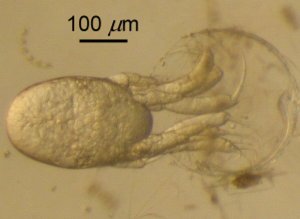
Krill go through several stages as they grow. After they hatch from an egg, they become different types of larvae. They shed their hard outer shell many times as they get bigger. Younger krill shed their shells more often. Baby krill get food from a yolk inside their bodies at first.
Once they are a bit older, they develop a mouth and start eating tiny ocean plants. At this point, they need to be in the upper parts of the ocean where there is enough sunlight for algae to grow. As they grow, they get more swimming legs. After their final larval stage, they become young krill that look like adults. Then they grow up and can have their own babies.
Reproduction
During mating season, male krill give a sperm packet to the female. Female krill can carry thousands of eggs, which can make up a third of their body weight! Krill can have many groups of babies in one season.
There are two main ways krill lay eggs:
- Most krill species release their fertilized eggs directly into the water. The eggs then sink and hatch on their own.
- Other species, called "sac spawners," carry their eggs with them in a special sac attached to their legs until the babies hatch.
Moulting
Krill shed their old, too-small outer shell (exoskeleton) as they grow. This is called moulting. Young krill moult more often because they grow faster. How often they moult depends on the species, water temperature, and how much food is available. For example, Antarctic krill can moult every 9 to 28 days. If there isn't enough food, Antarctic krill can even shrink their bodies by moulting to a smaller size!
Lifespan
Some krill species that live in very cold places can live for more than six years. Others, like those in warmer waters, might only live for two years or even just six to eight months.
Swarming
Most krill live in huge groups called swarms. These swarms can have tens of thousands of krill in just one cubic meter of water! Swarming helps protect krill from predators, as it makes it harder for a predator to pick out just one krill. When a swarm is disturbed, the krill scatter. Some krill can even shed their shell instantly to leave it behind as a decoy to confuse a predator.
Vertical Migration
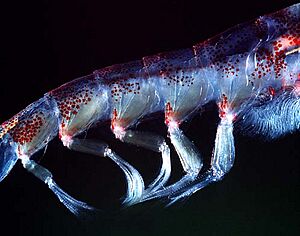
Krill usually move up and down in the water each day. They often spend the day in deeper water and then rise towards the surface at night. When they go deeper, they become less active. This helps them avoid predators and save energy. Krill that have just eaten swim less actively and sink. As they sink, they produce waste, which helps move carbon in the ocean. Krill with empty stomachs swim more actively to go up and find food.
Sometimes, krill form swarms near the surface during the day to feed or reproduce. This is risky because it makes them very easy targets for predators. Krill usually swim at about 5–10 cm per second using their swimming legs. When they are in danger, they can quickly flick their tails and shoot backwards through the water at much faster speeds, up to 80 cm per second!
Krill and Ocean Cycles
Antarctic krill are very important for how nutrients move around in the ocean and for the Antarctic food web. They help cycle nutrients and are a key food source for penguins and large whales.
How People Use Krill
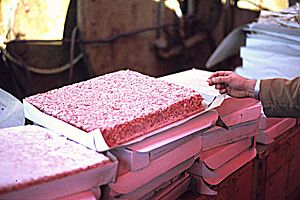
History of Krill Fishing
People have been catching krill for food for a long time, possibly even before the 1800s in Japan. Large-scale fishing for krill started in the late 1960s. Today, krill fishing mainly happens in Antarctic waters and near Japan. In the past, Japan and the Soviet Union caught the most krill. Now, countries like Norway, South Korea, and China are the main krill fishers.
To prevent catching too many krill, there are rules about how much can be caught each year. In 2018, many krill fishing companies agreed to stop fishing in large areas around the Antarctic Peninsula to protect penguins.
Eating Krill
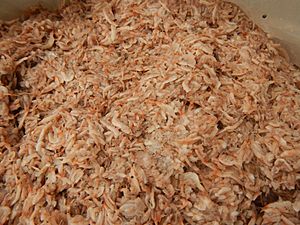
Even though there are hundreds of millions of tons of Antarctic krill, people are catching more of them. Krill are a good source of protein and healthy fats called omega-3 fatty acids. These are used in human food, as dietary supplements (like krill oil capsules), and in food for farm animals and pets. Krill taste salty, a bit like shrimp but with a stronger fish flavor. To eat them, their hard outer shell usually needs to be removed.
In Southeast Asia, krill are often fermented (with their shells on) and ground into a salty paste called shrimp paste. This paste is used to add flavor to many traditional dishes. The liquid from this process is also used to make fish sauce.
Krill-Inspired Robots
Scientists are studying how krill swim to help design new types of underwater robots. Krill are very good swimmers, and their movements can give ideas for robots that need to move well in water.
Images for kids
See also
 In Spanish: Kril para niños
In Spanish: Kril para niños
- Antarctic krill
- Cold-water shrimp
- Crustacean
- Krill fishery
- Krill oil
- Northern krill


